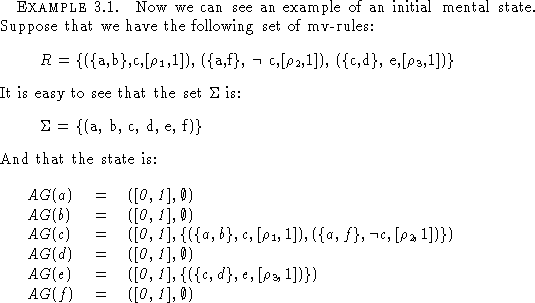
We propose a slight change of representation for mv-rules that allows us to simplify the functional descriptions of the algorithm.

For instance the rule (c ![]() d
d ![]() e,[
e,[ ![]() ,1])--written using the notation of
Section 2--will be represented from now on as the tuple:
,1])--written using the notation of
Section 2--will be represented from now on as the tuple:
![]() .
.
Next we define a representation for sets of rules and sets of
propositions that we will refer to as the mental state [17] of the
agent. The representation consists of mapping each atom in ![]() to
its current interval of truth-values and the (possibly empty) set of
mv-rules that conclude it, or its negation.
to
its current interval of truth-values and the (possibly empty) set of
mv-rules that conclude it, or its negation.

The representation of an agent's mental state will evolve as deduction proceeds. We represent the initial mental state of an agent as a mapping from any atom into [0,1] and the set of rules deducing it. It means that the atoms initially have their most imprecise value--that is [0.1], Axiom A1, Definition 1 in Section 2. Notice that an agent with all the atoms with truth-values [0,1] is always consistent in our calculus.
